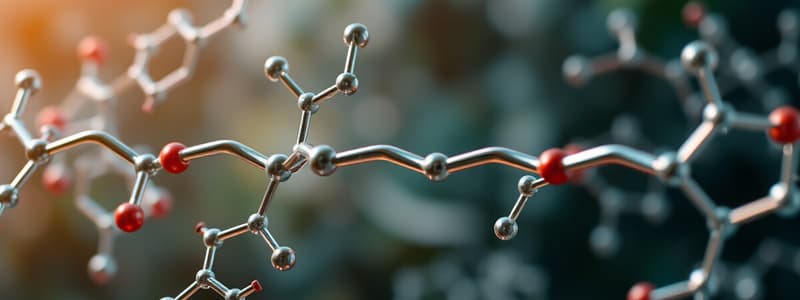Podcast
Questions and Answers
What is the primary consequence of nonenzymatic oxidation on collagen and glycosylated proteins?
What is the primary consequence of nonenzymatic oxidation on collagen and glycosylated proteins?
- Formation of carbon-carbon double bonds
- Development of advanced glycosylation end-products (AGEs) (correct)
- Increased solubility in water
- Creation of stable peptide bonds
How does a low pH affect protein structure?
How does a low pH affect protein structure?
- It increases hydrophobic interactions
- It disrupts ionic and hydrogen bonds formed by carboxylate groups (correct)
- It enhances ionic bond stability
- It solidifies the protein's tertiary structure
What effect does temperature have on protein denaturation?
What effect does temperature have on protein denaturation?
- It increases vibrational and rotational energies in bonds (correct)
- It only affects the hydrophobic interactions
- It decreases vibrational energy of bonds
- It stabilizes the three-dimensional conformation
What is a significant role of gastric juice in protein digestion?
What is a significant role of gastric juice in protein digestion?
How do hydrophobic molecules influence protein structure?
How do hydrophobic molecules influence protein structure?
What is the outcome of thermal denaturation as illustrated by the cooking of an egg?
What is the outcome of thermal denaturation as illustrated by the cooking of an egg?
What structural feature allows the β2-Adrenergic Receptor to span the membrane?
What structural feature allows the β2-Adrenergic Receptor to span the membrane?
What role do the extracellular loops of the β2-Adrenergic Receptor serve?
What role do the extracellular loops of the β2-Adrenergic Receptor serve?
Which of the following statements accurately describes the interaction of adrenaline with the β2-Adrenergic Receptor?
Which of the following statements accurately describes the interaction of adrenaline with the β2-Adrenergic Receptor?
What type of protein interacts with the β2-Adrenergic Receptor upon adrenaline binding?
What type of protein interacts with the β2-Adrenergic Receptor upon adrenaline binding?
Which posttranslational modifications are important for the β2-Adrenergic Receptor's structure?
Which posttranslational modifications are important for the β2-Adrenergic Receptor's structure?
What prevents the β2-Adrenergic Receptor from being static within the membrane?
What prevents the β2-Adrenergic Receptor from being static within the membrane?
What initiates the signaling cascade triggered by the β2-Adrenergic Receptor?
What initiates the signaling cascade triggered by the β2-Adrenergic Receptor?
In terms of chemical groups, what is significant for the structure of transmembrane proteins like the β2-Adrenergic Receptor?
In terms of chemical groups, what is significant for the structure of transmembrane proteins like the β2-Adrenergic Receptor?
Why are the domains of the β2-Adrenergic Receptor crucial for its function?
Why are the domains of the β2-Adrenergic Receptor crucial for its function?
Which correctly describes the composition of a heterotrimeric G protein involved in signaling from the β2-Adrenergic Receptor?
Which correctly describes the composition of a heterotrimeric G protein involved in signaling from the β2-Adrenergic Receptor?
Which of the following statements about torsion angles is correct?
Which of the following statements about torsion angles is correct?
What is the main consequence of steric constraints in torsion angles?
What is the main consequence of steric constraints in torsion angles?
Which configuration is preferred due to steric interference of R groups?
Which configuration is preferred due to steric interference of R groups?
How do the -C=O and -NH groups behave over a pH range of 2.0 to 12.0?
How do the -C=O and -NH groups behave over a pH range of 2.0 to 12.0?
Which terminal group of a polypeptide is typically charged?
Which terminal group of a polypeptide is typically charged?
What role do side chains play in relation to torsion angles?
What role do side chains play in relation to torsion angles?
Whose properties determine the steric constraints on torsion angles?
Whose properties determine the steric constraints on torsion angles?
Which of the following groups is NOT considered an ionized group in polypeptides?
Which of the following groups is NOT considered an ionized group in polypeptides?
What best describes the nature of torsion angles in amino acids?
What best describes the nature of torsion angles in amino acids?
What is the role of the palmitoyl group in the amino terminus?
What is the role of the palmitoyl group in the amino terminus?
What is the primary structural composition of adult hemoglobin (HbA)?
What is the primary structural composition of adult hemoglobin (HbA)?
What distinguishes embryonic hemoglobin from adult hemoglobin in terms of chain composition?
What distinguishes embryonic hemoglobin from adult hemoglobin in terms of chain composition?
Which amino acids are primarily involved in the phosphorylation sites at the COOH terminus?
Which amino acids are primarily involved in the phosphorylation sites at the COOH terminus?
What characteristics do the membrane-spanning segments of certain ion channel proteins possess?
What characteristics do the membrane-spanning segments of certain ion channel proteins possess?
What advantage does embryonic hemoglobin provide in low oxygen tensions?
What advantage does embryonic hemoglobin provide in low oxygen tensions?
What defines the quaternary structure of proteins?
What defines the quaternary structure of proteins?
What term refers to proteins that differ in primary structure but retain the same function across different tissues?
What term refers to proteins that differ in primary structure but retain the same function across different tissues?
How much sequence homology do Creatine Kinase isoforms share?
How much sequence homology do Creatine Kinase isoforms share?
What types of noncovalent interactions contribute to the stability of quaternary structures in proteins?
What types of noncovalent interactions contribute to the stability of quaternary structures in proteins?
Which form of Creatine Kinase is produced in skeletal muscle?
Which form of Creatine Kinase is produced in skeletal muscle?
Which group of proteins typically shares a common structural feature related to membrane spanning?
Which group of proteins typically shares a common structural feature related to membrane spanning?
How many subunits are typically involved in a dimer?
How many subunits are typically involved in a dimer?
Which of the following statements about cardiac isoforms of Creatine Kinase is true?
Which of the following statements about cardiac isoforms of Creatine Kinase is true?
What is the primary role of Creatine Kinase isoforms?
What is the primary role of Creatine Kinase isoforms?
What is the significance of loops connecting membrane-spanning segments?
What is the significance of loops connecting membrane-spanning segments?
Which residues are primarily linked to oligosaccharides in the amino terminus?
Which residues are primarily linked to oligosaccharides in the amino terminus?
What evolutionary change is believed to lead to the formation of the ζ chain in embryonic hemoglobin?
What evolutionary change is believed to lead to the formation of the ζ chain in embryonic hemoglobin?
Which type of Creatine Kinase isoform is referred to as the cardiac isoform?
Which type of Creatine Kinase isoform is referred to as the cardiac isoform?
What is a characteristic feature of oligomers in protein quaternary structures?
What is a characteristic feature of oligomers in protein quaternary structures?
Flashcards are hidden until you start studying
Study Notes
Torsion Angles
- Rotation around the bond between α-carbon and α-amino group or carbonyl group can occur.
- Steric constraints limit rotation to maximize distance between amino acid side chains.
- Close proximity of side chain atoms is forbidden to maintain structural integrity.
- Torsion angles vary based on specific amino acid composition, influencing polypeptide secondary and tertiary structures.
- Trans configuration preferred due to steric hindrance in the cis configuration.
Uncharged but Polar Groups
- Peptide bonds feature -C=O and -NH groups, remaining neutral across a pH range of 2.0 - 12.0.
- Charged groups in polypeptides include N-terminal α-amino group and C-terminal α-carboxyl group, alongside ionized side chain groups.
Determination of Amino Acid Composition
- Adult HbA consists of two α and two β chains.
- Embryonic hemoglobin is composed of ε and ζ chains, evolving from mutations in duplicated α genes, providing higher O2 affinity for the fetus.
- Tissue-specific isoforms, or isozymes, differ in primary structure but retain similar functions across tissues.
Creatine Kinase Isoforms
- Composed of two subunits, showing 60-72% sequence homology, and bind to muscle sarcomeres.
- M Form (MM creatine kinase) is expressed in skeletal muscle.
- B Form (BB creatine kinase) is produced in the brain.
- Cardiac isoforms include heterodimer MB and MM dimer; additional forms include heart mitochondrial creatine kinase.
Posttranslational Modifications
- Proteins often undergo modifications post-translation, influencing three-dimensional structure and function.
- Example: β2-Adrenergic Receptor features membrane-spanning domains made of α-helices with hydrophobic residues.
- Conformational changes in helices upon ligand binding (e.g., adrenaline) activate intracellular domains that recruit signaling proteins.
Ion Channel and Transport Proteins
- Share similar membrane-spanning segments with hydrophobic residues exposed to the lipid bilayer, maintaining structural integrity.
- Rigid helices connected by loops of hydrophilic amino acids interact with the aqueous environment.
Quaternary Structure of Proteins
- Defined by the specific arrangement and association of polypeptide subunits (dimers, tetramers, or oligomers).
- Functional proteins arise from the combination of subunits in a defined geometrical pattern.
Noncovalent Interactions
- Integral to protein structure stability: hydrophobic interactions, hydrogen bonds, and ionic bonds contribute to maintaining quaternary structure.
Nonenzymatic Oxidation
- Modifies proteins like collagen, forming advanced glycosylation end-products (AGEs) that aggregate into larger proteins.
Protein Denaturation
- Occurs due to environmental factors such as temperature, pH, and solvent composition, disrupting crucial ionic, hydrogen, and hydrophobic bonds.
- Low pH (e.g., gastric juice pH 1-2) disrupts ionic and hydrogen bonds without cleaving peptide bonds, aiding protein digestion.
- Elevated temperatures increase molecular vibrations, exemplified by the denaturation of albumin in cooking.
- Hydrophobic molecules, such as long-chain fatty acids, can disrupt protein structure by interfering with hydrophobic interactions, inhibiting enzyme function.
Studying That Suits You
Use AI to generate personalized quizzes and flashcards to suit your learning preferences.




